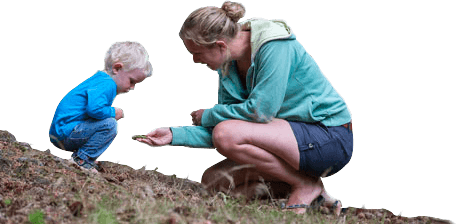5. Objective – Nature Recovery
Re:New Forest – Partnership Plan
Nature Recovery Outcome: Habitats are more resilient, restored, expanded, connected and maintained to enable wildlife to thrive, both within and beyond the National Park.
Why is it important?
![]()
Why is it important?
The New Forest National Park is one of the most valuable areas for wildlife in Europe and has the highest proportion of designated nature conservation sites of any national park in the country (56% of the National Park is a Special Area of Conservation, Special Protection Area or Ramsar Site and a further 5% is non-statutory sites (SINCs)).
Even though they remain important we can no longer simply protect nature from harm through special sites and reserves. The unique mosaic of heathland, mires, grassland, woodlands rivers and ponds of the Open Forest; the fields, hedges and woodlands of the forest fringe; the species-rich floodplains of the Avon Valley; and the grazing marshes and saline lagoons of the coastal plain – all are under threat from a variety of factors including climate change, recreation pressure, new diseases and invasive species.
The condition of the New Forest Sites of Special Scientific Interest (SSSIs) has shown a slight increase in recent years as a result of large-scale habitat restoration work under the New Forest Higher Level Stewardship scheme, with 53% in favourable condition (2022). There is no comprehensive assessment of the condition of non-statutory wildlife sites.
Urgent action is needed to ensure our habitats are more resilient, better managed, bigger and more joined up. Ecosystems need to be restored and wildlife needs to be able to move through the landscape freely if it is to adapt to change, which means looking beyond the Open Forest and working across the wider countryside.
The New Forest is well placed to drive a nature recovery network locally, in particular through increased connectivity within and beyond the boundaries of the National Park. Nature cannot recover if it is restricted to isolated pockets and therefore we need to ensure the nature recovery network is joined up across a landscape scale.
Nature Recovery is a major commitment in the Government’s 25 Year Environment Plan and the Government is putting National Parks at the heart of driving forward and delivering nature recovery and building our resilience to climate change. The Government has also committed to protect 30% of land in the UK by 2030 to support nature recovery. By bringing together partners, legislation and funding, we can make an important contribution to this target and provide nature-based solutions that will restore ecosystems, habitats and prioritise key species for recovery and reintroduction.
Our priorities
We will work together, and at scale, to maintain, reconnect and enhance nature. We commit to developing a nature recovery programme for the National Park that:
2.1. Makes more space for nature through:
2.1.1. Restoration and expansion of the Open Forest heath, mire and pasture woodland habitats; inclosures suitable for restoration and sites that share a common boundary with the Open Forest
2.1.2. Enhancing grassland and open habitats, rejuvenating hedgerows, woodland and arable habitats of the forest fringe
2.1.3. A programme of river, wetland restoration and pond creation
2.1.4. Opportunities for coastal realignment and saltmarsh restoration
2.1.5. Opportunities to reduce flood risk by working with natural processes within catchments
2.1.6. A programme of halting and reversing the decline of priority species, supporting species recovery, reintroduction of native species where appropriate and control of invasive species.
2.2. Enhances Natural Capital by:
2.2.1. Valuing and accounting for the public goods provided by the New Forest
2.2.2. Providing accessible nature-rich green space near to where people live
2.2.3. Incorporating natural capital in our policies and programmes
2.2.4. Generating opportunities for increased investment in ecosystem services
2.2.5. Coordinating research to better understand the role of peat and other carbon stores in the New Forest.
2.3. Supports nature recovery through the new Environmental Land Management Scheme (ELMS) by:
2.3.1. Working with and through the ‘Forest Farming Group’ to develop a common approach to land management which delivers on the 25 Year Environment Plan’s ambition of ‘public money for public goods’
2.3.2. Taking a collaborative approach with private landowners, farmers, land managers and conservation charities
2.3.3. Continuing to provide advice to landowners, farmers and commoners
2.3.4. Providing support for ELMS Test and Trial projects and farm cluster groups across the National Park.
2.4. Ensures developers deliver a wider range of environmental benefits over and above the full environmental impact of the proposed development by:
2.4.1. Having clear and up-to-date planning policies and new supplementary planning guidance that maximise this Biodiversity Net Gain (BNG) through new development
2.4.2. Adopting a Design Code for new buildings
2.4.3. Developing a better understanding of the impact of development and activities on dark night skies and taking opportunities to mitigate those impacts.
2.5. Mitigates recreational pressures by:
2.5.1. Developing a spatial plan for where recreation should be accommodated in the New Forest and surrounding areas
2.5.2. Agreeing a strategy to facilitate changes to the location and capacity of car parking on the Open Forest and adjacent commons
2.5.3. Developing a strategic approach to mitigate the potential impacts associated with increasing recreational pressures arising from planned new housing and visitor accommodation on the internationally designated habitats
2.5.4. Increasing the level of funding available for recreation management so that it is sufficient to address both existing and future needs
2.5.5. Using appropriate and proportionate enforcement strategies to deter illegal use of the Forest.
Next page: 6. Objective – An Inclusive National Park



